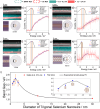Flexible Selenium Nanowires with Tuneable Electronic Bandgaps
- PMID: 40395144
- PMCID: PMC12355565
- DOI: 10.1002/adma.202501821
Flexible Selenium Nanowires with Tuneable Electronic Bandgaps
Abstract
Manipulating semiconductor properties without altering their chemical composition holds promise for electronic and optical materials. However, linking atomic positions in nanomaterials to their functional properties is challenging due to their polydispersity. This study utilizes nano test tubes to uncover distinct phases of selenium, an elemental semiconductor, demonstrating a remarkable structural plasticity between 0.4 and 3.0 nm. These structures are correlated with their electronic bandgaps, ranging from 2.2 to 2.5 eV, using ultra-low-loss electron energy loss spectroscopy and aberration-corrected scanning transmission electron microscopy for individual nanowires in boron nitride nanotubes (BNNT). Notably, the variation in bandgaps diverges from that of bulk selenium and is non-monotonic on the host-nanotube diameter, indicating that conformational distortions in selenium chains begin counteracting quantum confinement effects at sub-nm scales. A 1D phase diagram predicting selenium's atomic structure based on nanotube diameter, regardless of the chemistry of the host nanotube is developed, which can be BNNT or carbon nanotubes. Phase changes in selenium nanowires are imaged in real-time by transmission electron microscopy using BNNT as a test tube with an adjustable diameter. These nanoscale findings pave the way for the development of advanced miniature tuneable and flexible electronic components, including transistors, optical sensors, and photovoltaics.
Keywords: bandgap; boron nitride nanotubes; carbon nanotubes; nanowires; phase change; selenium; transmission electron microscopy.
© 2025 The Author(s). Advanced Materials published by Wiley‐VCH GmbH.
Conflict of interest statement
The authors declare no conflict of interest.
Figures





References
-
- Boyd R., Nat. Chem. 2011, 3, 570. - PubMed
-
- Smith W., Nature 1873, 7, 303.
-
- Smith W., J. Soc. Telegraph Eng. 1873, 2, 31.
-
- Adams W. G., Day R. E., Phil. Trans. R. Soc. 1877, 167, 313.
-
- Fritts C. E., Am. J. Sci. 1883, s3‐26, 465.
Grants and funding
LinkOut - more resources
Full Text Sources

